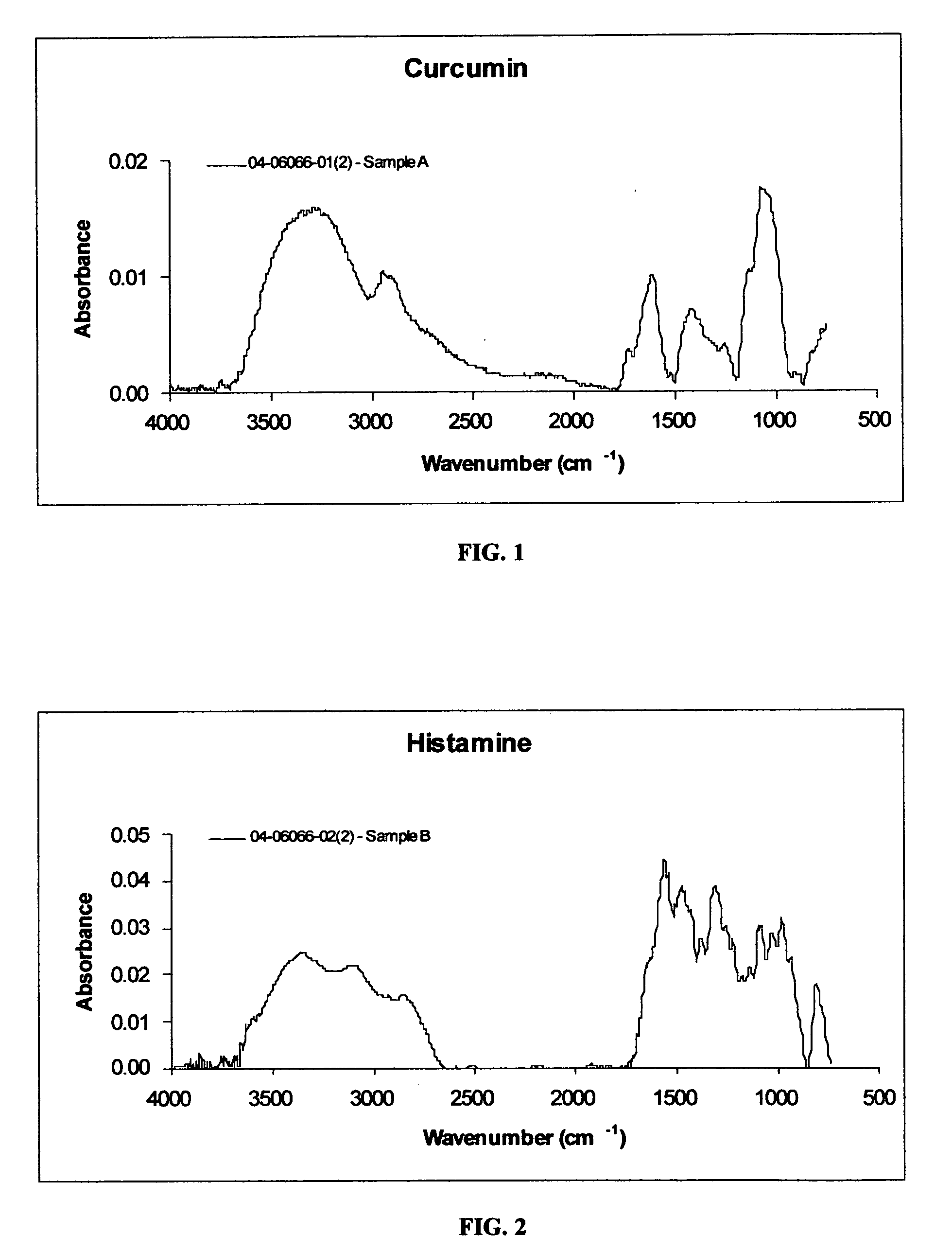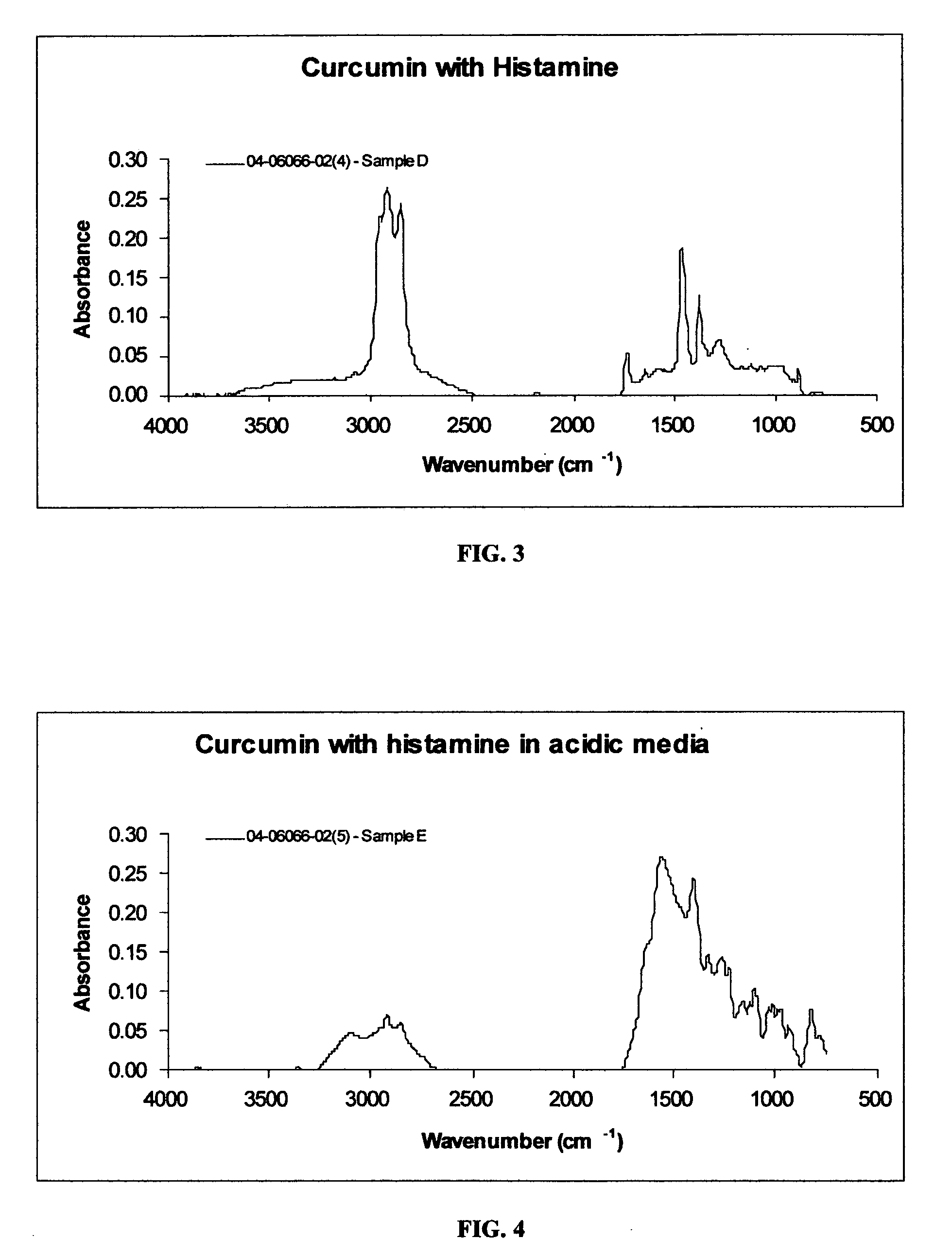Compositions and methods for the treatment of allergic rhinitis
- Summary
- Abstract
- Description
- Claims
- Application Information
AI Technical Summary
Benefits of technology
Problems solved by technology
Method used
Image
Examples
example 1
[0054] In Example 1, curcumin was obtained from Spectrum Chemical Company, Gardena, Calif. Histamine was procured from Aldrich Chemicals. The reported molecular weights of curcumin and histamine are 368 and 111, respectively. The FT IR spectra of curcumin and histamine are provided in FIG. 1 and FIG. 2, respectively.
[0055] As may be seen in FIG. 1, the infrared spectrum of curcumin exhibits: an O—H stretching absorption band at 3286 cm−1; C—H stretching absorption bands at 2951 cm−1 and 2916 cm−1; a ketone carbonyl stretching absorption band at 1735 cm−1; an enol carbonyl stretching absorption band at 1620 cm−1; C—H bending absorption bands at 1431 cm−1 and 1365 cm−1; and C—O stretching absorption bands at 1261 cm−1, 1145 cm−1 and 1076 cm−1. The foregoing is typical of a ketone-based material.
[0056] As shown in FIG. 2, the infrared spectrum of histamine exhibits: an N—H stretching absorption band at 3352 cm−1; C—H stretching absorption bands at 2927 cm−1 and 2856 cm−1; a C—N stret...
example 2
[0057] Curcumin is known to have very limited solubility in common solvents, including water. Due to its low solubility, solutions of curcumin and histamine were initially prepared at a 4:1 molar ratio of curcumin to histamine. In order to improve the solubility of the curcumin, its solution in isopropyl alcohol was warmed at 37° C. for 30 minutes and filtered. The histamine solution in isopropyl alcohol was then slowly added to the filtered curcumin solution under stir. The mixture was allowed to evaporate and dry at ambient conditions. The FT IR spectrum of the resultant product is provided in FIG. 3.
[0058] The infrared spectrum of the resultant product of curcumin and histamine in FIG. 3 exhibits an N—H absorption band as a broad shoulder around 3352 cm−1, indicating that the product is not fully converted. The C—H stretching bands at 2955 cm−1, 2922 cm−1 and 2854 cm−1; ketone carbonyl stretching band at 1735 cm−1; and enol carbonyl stretching band at 1643 cm−1 are exhibited in ...
example 3
[0059] Initial solutions of curcumin and histamine at 4 to 1 molar ratio were prepared in isopropyl alcohol. Drops of glacial acetic acid in the form of a 10% solution were added to the curcumin solution to adjust the pH to between 4 and 5. The solution was then warmed at 37° C. for 30 minutes and filtered. The histamine solution was gradually added to the clear curcumin solution under slow agitation. The resultant composition was allowed to dry at ambient conditions. An infrared spectrum of the resultant product is given in FIG. 4. Examples of acids which may be used according to the teaching of the present invention, in addition to acetic acid used in Example 3, include, but are not necessarily limited to: ascorbic acid, citric acid and acetic acid, taken alone or in combination with any of the foregoing.
[0060] The infrared spectrum of the 4 to 1 mixture of curcumin and histamine prepared according to Example 3 shown in FIG. 4 exhibits: an O—H stretching absorption band at 3100 c...
PUM
| Property | Measurement | Unit |
|---|---|---|
| Composition | aaaaa | aaaaa |
| Acidity | aaaaa | aaaaa |
Abstract
Description
Claims
Application Information
 Login to View More
Login to View More - R&D
- Intellectual Property
- Life Sciences
- Materials
- Tech Scout
- Unparalleled Data Quality
- Higher Quality Content
- 60% Fewer Hallucinations
Browse by: Latest US Patents, China's latest patents, Technical Efficacy Thesaurus, Application Domain, Technology Topic, Popular Technical Reports.
© 2025 PatSnap. All rights reserved.Legal|Privacy policy|Modern Slavery Act Transparency Statement|Sitemap|About US| Contact US: help@patsnap.com



